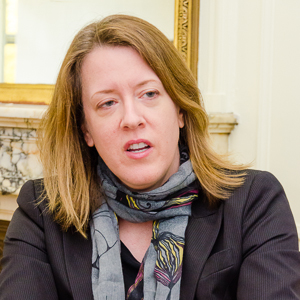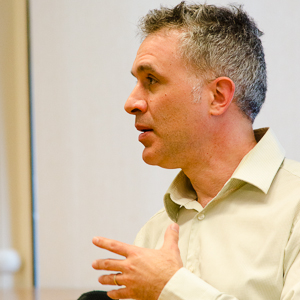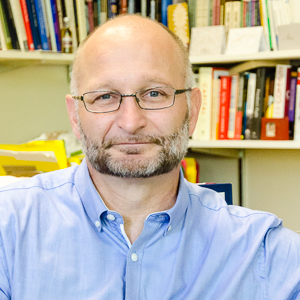
Researchers at the Centre for Intellectual Property Policy take a hands-on look at where new ideas come from and what we do with them
by Mark Witten
A comparison of Montreal and Silicon Valley’s legal and regulatory rules. An educational documentary. A public interest lawsuit at Federal Court. A journal article on how the presence of the digital cloud affects copyright.
Legal research comes in all shapes and sizes and these are just some of the examples of current research underway at the Faculty of Law’s Centre for Intellectual Property Policy (CIPP).
The CIPP is a hub for research and action, through which its members and collaborators on five continents carry out cutting-edge research in the realms of technological and artistic innovation.
A key to keeping these research findings relevant is to communicate the results clearly and openly to the people who need the information and the Centre disseminates its findings not only through workshops, conferences and academic publications, but also public discourse in the media, appearances before parliamentary committees and the submission of educational briefs to the courts.
Three action-oriented research initiatives by CIPP members — Professors Pierre-Emmanuel Moyse (its current director), Allison Christians, Richard Gold, and David Lametti – look at how existing intellectual property laws and practices may often deter rather than spur innovation. This critical questioning leads to new ideas and perspectives on how the law can best advance creativity and the broad dissemination of knowledge – hence innovation – in a global context.
Law and the Creative District

In their research project, “Regulating Innovation: Law and the Creative District,” Christians and Moyse are investigating how legal institutions, regulations and the ability to enforce the law affect the creation and development of new ideas, products and methods. Through literature reviews and field interviews with industry employers and employees in creative roles, they plan on examining the effects of varying legal and regulatory rules and practices in several innovative districts, including Montreal and Silicon Valley.
The team conceived of this project as an opportunity to look at two areas of law that are drivers of innovation – intellectual property and taxation – and chose Montreal because its aggressive tax incentives and rigorously enforced non-compete covenants were developed for the purpose of attracting innovation to the area.
These non-compete covenants keep company knowledge confidential, and restrict the mobility and ability of employees to share their creations and know-how within the district while also attributing ownership of intellectual property to employers rather than employee-creators to attract businesses.
Moyse and Christians examine Montreal’s intellectual property and tax landscape by looking at foreign experiences and regulation methods. Unlike Montreal, California doesn’t enforce non-compete covenants and it is experimenting with arrangements that allow the employee-creator to benefit from a partial ownership interest in profits stemming from his or her creation. There are also relatively few tax incentives offered directly to Silicon Valley companies, although businesses do benefit from low state taxes and a federal tax regime that allows multinational technology companies to easily move their profits to offshore havens with a 0% tax rate.
Moyse questions the value of non-compete covenants in advancing innovation.
“Our hypothesis is that contractual non-compete agreements between employers and employees could have a negative impact on innovation and the circulation of knowledge within a district,” he explains. Instead, these agreements may deter innovation because people who work in creative fields might not feel that they can best use their talents in their work environment. The goal of the project is to test these hypotheses in interviews with technology industry owners and employee-creators.
The most constructive and useful way for law to advance innovation, Moyse says, may be to remove or bend the rules and regulations that impede it within a district. “Our goal is to push for a system where you have no anti-compete covenants and no IP as we have traditionally conceived of them. These legal instruments as currently used may create locks on innovation. These are provocative thoughts, which we hope will change the nature of the conversation and broaden the public discussion of these issues,” he says.
IP tax break perils

Professor Allison Christians is a tax law specialist and co-investigator with Moyse on this CIPP research project. She will look at the economic effects of tax incentive schemes governments use to attract technology companies. Examples of these tax regimes include research and development (R&D) credits, tax holidays, and patent boxes, which offer reduced tax rates on profits from IP licensing or products derived from patents in that jurisdiction.
States increasingly offer such tax incentives in the hope of gaining a net benefit from increased jobs and consumer spending resulting from technology businesses locating in that district. But Christians questions whether these tax regimes have the intended effect of attracting technology or innovation businesses to a given jurisdiction and whether the innovation district really gains the promised economic benefits.
“Our hypothesis is that tax incentives are not driving business decisions about where to locate. If governments offer tax incentives, businesses will gladly take them but enterprises and innovators are motivated to locate in places where the workforce has access to good education, social services and health care,” says Christians, the H. Heward Stikeman Chair in Tax Law.
Indeed, Christians argues, government tax policies are key to creating a healthy society that is a foundation for innovation, but many current government tax policies encourage tax avoidance and represent a larger governance crisis.
U.S. congressional hearings revealed that Apple, for example, had successfully avoided US$44-billion in taxes from 2009 to 2012. One common tax avoidance method is a clever IP manoeuvre, which involves moving a patent or trademark to a subsidiary in a low-tax jurisdiction, charging a royalty to subsidiaries in other countries for using it, and in this way shifting profits away from higher-tax countries.
Christians argues that new governance policies are needed that would require technology companies to pay their fair share of taxes to support the social and educational infrastructure that encourages innovation and broad dissemination of knowledge. “Taxes pay for the good education and social services that build a healthy society that is a foundation for innovation,” she says.
A final product of the study by Christians and Moyse will be a storyboard and script outline for an educational documentary, which would use the 2011 Martin Scorsese film, Surviving Progress, as a model. “We don’t want to stop with the publication of academic papers. We’ll move on from there and have more impact on planning policy with a documentary through which the issues and arguments can be presented to a non-academic viewer,” says Christians.
Gene patent action promotes innovation and public access

Like his CIPP colleagues, Richard Gold sees the need for academics to translate their research into policy actions that have an impact in the real world of technological innovation. In November of last year, Gold announced his involvement in the Children’s Hospital of Eastern Ontario (CHEO) legal action, filed in Federal Court, challenging the U.S. patent holders of five human genes related to Long QT syndrome, a rare heart disorder. He says that the purpose of his involvement is to develop patent law so that it supports Canada’s public health care system.
Gold is leading an international team of lawyers, academics and scientists, who are offering their expertise on gene patenting and the delivery of medical care. The case addresses issues not only of genetics but also of policymaking and its consequences and Gold has previously tackled this subject, most notably in 2013, when he submitted an amicus brief to the U.S. Supreme Court in Association for Molecular Pathology et al v. Myriad Genetics, based on his research. The court ruled that it isn’t possible to patent naturally occurring genes because they are products of nature, invalidating the patents on the BCRA1 and BCRA2 genes (associated with an increased risk of breast and ovarian cancer) in the U.S.
Because it is a US decision, it tells us little about whether the thousands of gene patents that exist in Canada are valid or not, because Canadian courts haven’t addressed the issue. Gold thinks Canadian legislators are unlikely to intervene to change the patent statutes. So he and his colleagues worked with CHEO: a leading Canadian health care institution that delivers and develops genomic medicine, which was keen to bring the issue before the courts.
“There isn’t a lot of public intervention in Canadian patent law. The CHEO action was launched as a test case to get clarity on whether gene patents are valid in Canada. The U.S. Supreme Court ruled these types of patents are invalid, but we have no similar ruling in Canada. We need to restore certainty about the rules for the benefit of patients and innovators,” says Gold, James McGill Professor and a founding director of the Centre for Intellectual Property and Policy.
The patents in this case relate to Long QT syndrome, a heart rhythm disorder that can trigger sudden fainting spells, seizures or sudden death. If detected, the condition is treatable; but a substantial portion of cases can only be detected through the combination of a genetic test. If not found, the patient may die without warning, often at a very young age.
The U.S. company that holds rights to the patents on the tests and the genes complained when the Ontario government tried to have the test done in Canada. As CHEO could perform the necessary genetic screening for Long QT syndrome for less than half the US$4,500 it costs to have the analysis done by authorized firms in the U.S., this represents a significant extra cost to the health care system.
Beyond that, the hospital claims gene patents have a chilling effect the future of genetic medicine in Canada. For example, while CHEO was able to secure a contract from the Ontario Ministry of Health and Long Term Care to provide screening for a large number of inherited cardiac disorders, it had to exclude the LQ syndrome genes after a warning from the patent holder.
Gold sees Canadian companies and researchers losing out because single gene patents deter them from developing new, multi-gene tools in genomic medicine, whereas their American competitors are free to innovate without fear of gene patent shackles.
“We have the worst of both worlds right now. Companies assume gene patents are invalid in Canada, but hospitals assume they are valid. We don’t get the investment in research and we’re not part of developing knowledge, but we get all the costs. We want legal certainty in a way that increases innovation,” he says.
Copyright, creativity and the common good

“It’s important for academic researchers to participate in the public debate on intellectual property issues,” says another CIPP member, David Lametti, who researches copyright, patents and technological innovation.
His most recent area of focus is that of the digital cloud and whether tech companies will act as gatekeepers, owning and controlling their respective cloud domains, thus diminishing open access and limiting innovation by users. In “The Cloud: Boundless Digital Potential or Enclosure 3.0?,” published in Virginia Journal of Law & Technology, Lametti observes that the cloud is “manageable” in a way that the internet was not. Cloud service providers will have an enhanced ability to control or manage users as their power grows.
Lametti suggests that the internet, with all its associated technological innovations and virtually unlimited dissemination of knowledge, wouldn’t have developed and evolved in such an organic and creative way if the rights of copyright holders had been broadly and rigidly enforced at the expense of users.
“If we’d been harder on copyright, we could have shut the Internet down,” he says, pointing to the ways in which music sampling pushed and changed the boundaries of music and of the recording industry itself. “Our culture would be so much poorer if some of that creativity had been stifled.”
Lametti sees a cultural shift taking place in which our relationship to technology is defined increasingly by passive information absorption rather than one of control or influence. The digital cloud may reduce the range of user possibilities for strong interaction even further, in a way that prevents our participation as creators, collaborators and sharers. So he urges policy action to encourage or, if necessary, legal measures to force private technology businesses to keep the cloud open and accessible in the long term and also proposes a publicly held cloud to achieve this goal for the common good.
“Users shouldn’t be digital sheep,” he says. “We should be digital shepherds.”
Allison Christians and Pierre-Emmanuel Moyse’s project is funded by an Insight Development Grant from the Social Sciences and Humanities Research Council.
Richard Gold and his team are funded through PACEOMICS, a project supported by Genome Canada, Genome Alberta, Genome Quebec and the Canadian Institutes for Health Research; the Social Sciences and Humanities Research Council; and the Stem Cell Network.
